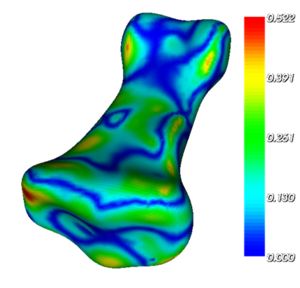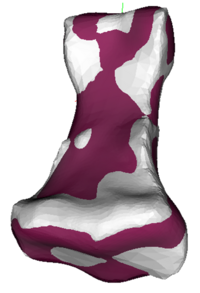Difference between revisions of "Validation of Defined Regions of Interest Using Surface Scanning"
From NAMIC Wiki
| (7 intermediate revisions by the same user not shown) | |||
| Line 15: | Line 15: | ||
| − | ''' | + | '''Publications:''' |
| − | * | + | * DeVries NA, Gassman EE, Kallemeyn NA, Shivanna KH, Magnotta VA, Grosland NM. [http://www.springerlink.com/content/u36v5957k17536wt/ Validation of phalanx bone three-dimensional surface segmentation from computed tomography images using laser scanning]. Skeletal Radiol. 37(1):35-42, 2008. |
| − | + | ||
| − | |||
| − | |||
'''Key Investigators:''' | '''Key Investigators:''' | ||
| Line 28: | Line 26: | ||
*[http://www.ccad.uiowa.edu/mimx Musculoskeletal Imaging, Modelling and Experimentation (MIMX)] | *[http://www.ccad.uiowa.edu/mimx Musculoskeletal Imaging, Modelling and Experimentation (MIMX)] | ||
| − | ''' | + | '''References:''' |
| − | + | * [http://www.springerlink.com/content/u36v5957k17536wt/ Devries NA, Gassman EE, Kallemeyn NA, Shivanna KH, Magnotta VA, Grosland NM. Validation of Phalanx Bone 3D Surface Segmentation from CT Images Using Laser Scanning, Skeletal Radiology, 2007] | |
| + | |||
| + | '''Figures:''' | ||
| + | |||
| + | [[Image:DistanceMapTool.jpg|left|thumb|300px|Surface distance mapping tool developed in FLTK]] | ||
| + | |||
| + | [[Image:DistanceMap.png|left|thumb|300px|Surface Distance Map for a phalanx bone between a surface manually defined via CT and a physical surface laser scan.]] | ||
| + | |||
| + | [[Image:SurfaceOverlay.png|left|thumb|200px|Overlay of the physical surface (White) and CT based surface (Purple)]] | ||
Latest revision as of 18:32, 20 January 2010
Home < Validation of Defined Regions of Interest Using Surface ScanningObjective:
- To evaluate manual and automated segmentation routines using surface scans of disected bones from cadaveric specimens
Progress:
- CT images of the hand and wrist have been obtained
- Four hands have been disected and bones extracted
- Surface scanning for these disected bones is completed using a Roland LPX-250 Laser Scanner
- Manual tracing of the CT images is completed
- Evaluate reliability of the manual tracers is complete using relative overlap
- Tools have been developed to reorient surface axes and to register the manually defined model and the surface resulting from laser scanning
- Distance maps for the manual segmentation have been generated.
- The effect of various post processing routines have been studied relative to changes in the surface geometry relative to the laser scan.
Publications:
- DeVries NA, Gassman EE, Kallemeyn NA, Shivanna KH, Magnotta VA, Grosland NM. Validation of phalanx bone three-dimensional surface segmentation from computed tomography images using laser scanning. Skeletal Radiol. 37(1):35-42, 2008.
Key Investigators:
- Iowa: Nicole Grosland, Vincent Magnotta, Nicole DeVries
Links:
References:
Figures:


